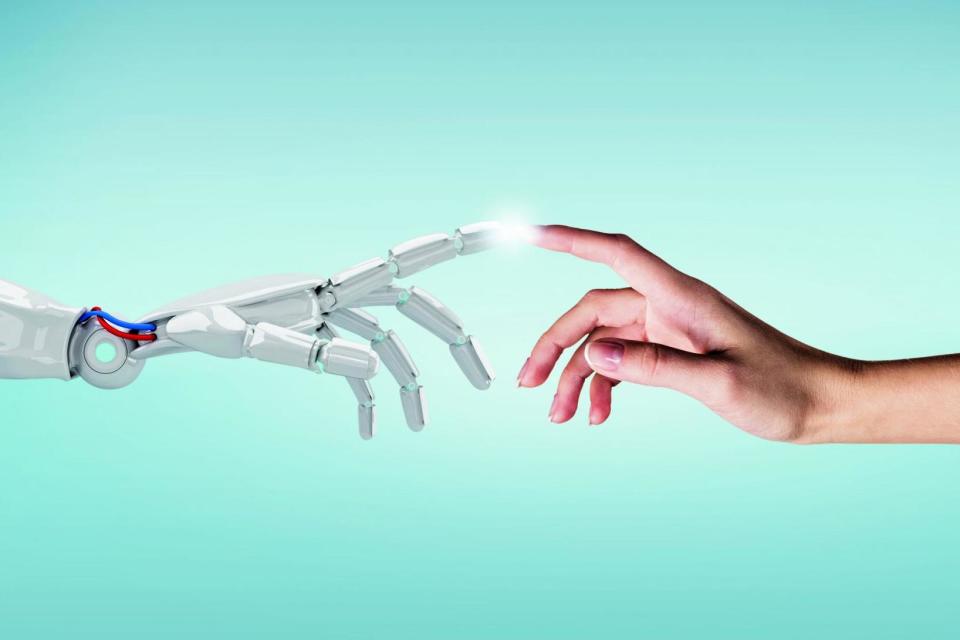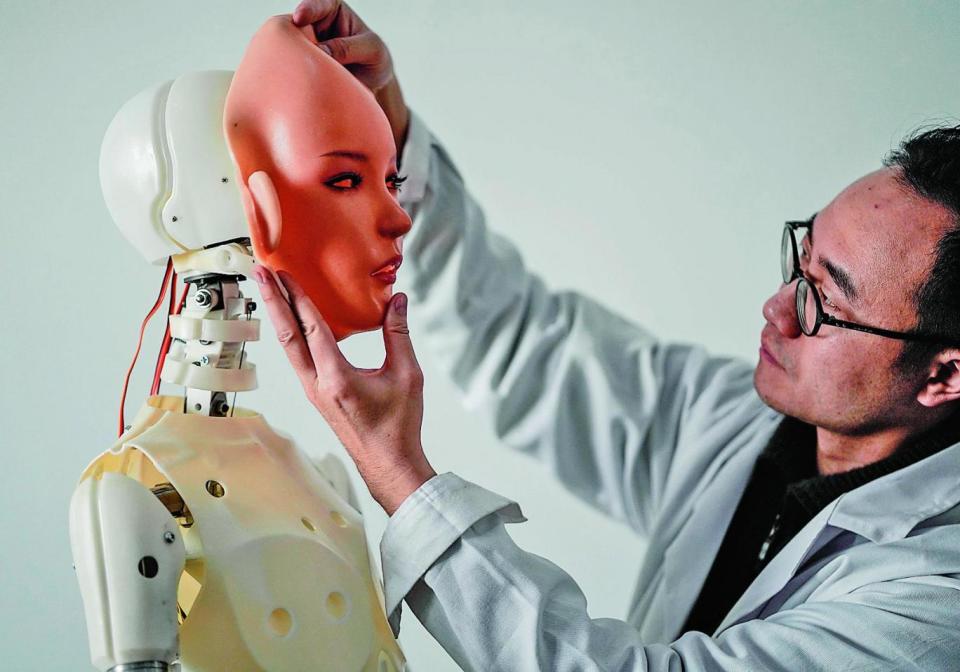Sleeping with the enemy: the rise of sex machines

Last summer, a raven-haired, 5ft 4in, 7-stone ingenue took Covent Garden by storm.
Known only by her first name, Samantha spent a whole month perched coquettishly on a display cabinet in a sex shop called Liberation. Curious customers were encouraged to ‘feel her body’. As the first sex doll equipped with artificial intelligence ever to hit the capital, Samantha may have been a visitor from London’s sexual future — where sex robots become so advanced they are interchangeable with human beings.
Today, primitive types of these sci-fi beings are part of a lucrative sex technology industry, estimated to be worth more than £20 billion. But Arran Squire, co-founder of Synthea Amatus, the company that made Samantha (who costs £5,320 and can be bought under a variety of names on the Synthea Amatus website), thinks his industry is about to boom. ‘In 15 to 20 years it will be worth £200-300 billion,’ he claims. By then, he says, ‘you won’t be able to tell the difference, by talking, between a robot and a human. Obviously you’ll still know by looking, but to talk and react it’ll be the same as a human.’
For now, Squire estimates that he has about 30 to 40 customers in the UK. His client list is a closely guarded secret but he is open about his own experience of Samantha. ‘The physical feeling is actually very similar to real life,’ he explains. ‘It’s actually the first sex robot in the world to synchronise the orgasm to the user.’

Squires and his business partner Dr Sergi Santos aren’t the only ones hoping the market for sex robots takes off. Later this year, American entrepreneur Matt McMullen, of RealDoll and Realbotix, is expected to release Harmony, a £7,000 fully functioning robot head that will be capable of blinking, talking and smiling. The head will exist as an add-on to one of RealDoll’s existing sex dolls, instantly transforming her into a being with a mechanically articulated neck and a skull base to which different faces may be attached. She is run by an AI mobile app, so her responses and mannerisms can be synchronised by Bluetooth. McMullen already has some enthusiastic customers-in-waiting. David Mills, a 69-year-old divorcee from Huntingdon, West Virginia, tells me he’ll be ‘first in line’ for the upgrade. ‘There’s no man on earth who’s more enthusiastic about this stuff than I am,’ claims Mills. ‘I always buy the new iPhone.’
If this technology is adopted with the same vigour with which the masses have embraced Apple, McMullen may be about to make a fortune. In all the preview videos so far released, Harmony seems a ‘she’ rather than an ‘it’ — eerily lifelike, batting her eyelashes and answering questions in a flirtatious manner. Soon whole-bodied iterations, the Realbotix website promises, will include internal heating so her skin feels warm and sensors so she ‘responds’ to touch. The company is also hoping to increase its customer base (currently more than 95 per cent male) by releasing a male sex robot equipped with a bionic penis.

McMullen, who works in California, started out making Halloween masks and switched to making sex dolls in 1994 when he posted pictures of a mannequin he had made on the internet and received requests to remake it — with entry points. Ever since then, he has insisted that his humanoid creations are not ‘just about sex’. Mills says he uses his doll as a sex toy — like a woman would a vibrator, purely to achieve orgasm — but most sex doll owners, claims Dr Kate Devlin of Goldsmiths University, feel they are in love with their dolls. ‘They are, by and large, incredibly respectful and caring,’ she explains. ‘Love doesn’t have to be reciprocated to be valid — we know that from people who’ve had crushes on other people.’
Sociologically and psychologically, some experts think that sex dolls could aid our sexual future — if we can only keep an open mind on the subject. ‘We’re starting to really understand the huge cost of isolation to people’s wellbeing,’ adds Professor Neil McArthur, co-author of Robot Sex: Social and Ethical Implications. ‘I think sexual isolation is a big part of that and sex robots can provide at least part of a solution. They could really help a lot of people who, through no fault of their own, don’t necessarily have other options.’
McArthur even suggests that sex robots might be of use in helping sexually frustrated spouses stay married, pointing to a line written by the American relationship advice columnist Dan Savage: ‘Relationship graveyards around the world are crowded with tombstones that read: “Everything was great… other than the sex.”’ Indeed in one online poll 40 per cent of people answered ‘no, it wouldn’t bother me’ to the question, ‘does it still count as cheating if your partner has sex with a real-life looking sex robot?’ In Germany and Spain, there are already robot brothels and some hope sex robots will eradicate the ‘world’s oldest profession’: prostitution.
The author David Levy goes a step further, predicting that sex robots won’t just exist to exercise any frustrated libidos. Soon enough, we’ll be falling in love with them ‘in droves’. He predicts that the first human-robot marriages will take place by 2050. ‘I think there’s an important point here,’ he argues. ‘If I’d said to you a hundred years ago that people of the same sex would be marrying each other in a hundred years’ time, you’d have me carted off to the nearest lunatic asylum. Look how wrong you would have been.’ He thinks ‘women will be just as interested as men’, but admits, ‘my wife doesn’t agree with me at all… She thinks that any man who is interested in having sex with a robot has something wrong with him.’

Dr Kathleen Richardson of De Montfort University, Leicester, and founder of the Campaign Against Sex Robots, is concerned that what underpins the production and sale of sex robots is the notion of ‘using others as objects’ and compares the purchase of them to the buying of real women. ‘Men who visit prostitutes don’t take her or him out for coffee, get to know them, find out if they’re mutually attracted to each other, and decide to have a sexual encounter. They bypass it all and visit someone who will basically do what they want.’ She argues that Harmony, who is programmed to flirt and bat her eyelashes whenever a man flips the right switch, is an extension of this, a being who perpetuates the idea that ‘it is okay to use others for your own gratification and carry it forward into a new world of technology’.
Curiously, David Mills agrees with Dr Richardson in his conception of the sex robot he is poised to buy: that all she really amounts to is ‘Siri in a doll’. He’s buying Harmony now because he wants to be at the very forefront of cutting-edge sex technology — and at £7,000 a head, if he saves up, he can just about afford it.
‘I don’t hold on to the theory that next year’s doll is going to be able to cook dinner for me, play tennis with me,’ he concludes. ‘If they could build something like that it would cost a billion dollars.’
Emily Hill is the author of ‘Bad Romance’ (Unbound, £14.99)

 Yahoo News
Yahoo News 